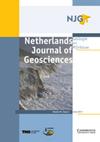Dark Ages woodland recovery and the expansion of beech: a study of land use changes and related woodland dynamics during the Roman to Medieval transition period in northern Belgium
IF 2.3
2区 地球科学
Q3 GEOSCIENCES, MULTIDISCIPLINARY
Netherlands Journal of Geosciences-Geologie En Mijnbouw
Pub Date : 2020-09-29
DOI:10.1017/njg.2020.11
引用次数: 9
Abstract
Abstract The results from analyses of botanical remains (pollen, wood, charcoal, seeds) from several archaeological features excavated in Kluizen (northern Belgium) are presented. The region was largely uninhabited until the Iron Age and Roman period when a rural settlement was established, resulting in small-scale woodland clearance. The site was subsequently abandoned from c. AD 270 till the High Middle Ages. The results of the archaeological and archaeobotanical analyses provide information on changes in land use and resulting dynamics of woodland cover and composition between c.600 BC and AD 1200, with a spatial and temporal resolution unrivalled in northern Belgium. Especially the long period of woodland regeneration following abandonment of the site around AD 270, covering the Late Roman and Early Medieval period, could be reconstructed in detail. Abandoned fields were first covered with pioneer woodland (Salix, Corylus and Betula), then Quercus-dominated secondary forest and finally a late-successional forest with Fagus sylvatica, Carpinus betulus and Ilex aquifolium, an evolution that took over 300 years. The results also indicate that the observed increase of Fagus during the Early Middle Ages, which was never an important element in the woodland vegetation in northern Belgium before, was related to climatic changes rather than anthropogenic factors.黑暗时代林地恢复和山毛榉的扩张:比利时北部罗马至中世纪过渡时期土地利用变化和相关林地动态的研究
摘要:本文介绍了在比利时北部Kluizen出土的几个考古特征的植物遗骸(花粉、木材、木炭、种子)的分析结果。该地区在铁器时代和罗马时期之前基本上无人居住,当时建立了农村定居点,导致小规模的林地砍伐。该遗址随后从公元270年到中世纪盛期被遗弃。考古和考古植物学分析的结果提供了关于土地利用变化和由此产生的林地覆盖和组成动态的资料公元前和公元1200年,其空间和时间分辨率在比利时北部无与伦比。特别是在公元270年左右,该遗址被废弃后,覆盖了罗马晚期和中世纪早期的长时间的林地再生,可以详细地重建。原始林地(柳、榛、桦树)、次生林(栎树)、晚演替林(Fagus sylvatica、Carpinus betulus、Ilex aquifolium)的发展历经300余年。结果还表明,中世纪早期比利时北部林地植被中Fagus的增加与气候变化有关,而不是人为因素。
本文章由计算机程序翻译,如有差异,请以英文原文为准。
求助全文
约1分钟内获得全文
求助全文
来源期刊
CiteScore
4.00
自引率
25.90%
发文量
14
审稿时长
>12 weeks
期刊介绍:
Netherlands Journal of Geosciences - Geologie en Mijnbouw is a fully open access journal which publishes papers on all aspects of geoscience, providing they are of international interest and quality. As the official publication of the ''Netherlands Journal of Geosciences'' Foundation the journal publishes new and significant research in geosciences with a regional focus on the Netherlands, the North Sea region and relevant adjacent areas. A wide range of topics within the geosciences are covered in the journal, including "geology, physical geography, geophyics, (geo-)archeology, paleontology, hydro(geo)logy, hydrocarbon exploration, modelling and visualisation."
The journal is a continuation of Geologie and Mijnbouw (published by the Royal Geological and Mining Society of the Netherlands, KNGMG) and Mededelingen Nederlands Instituut voor Toegepaste Geowetenschappen (published by TNO Geological Survey of the Netherlands). The journal is published in full colour.

 求助内容:
求助内容: 应助结果提醒方式:
应助结果提醒方式:


